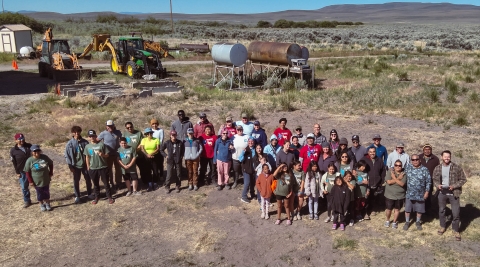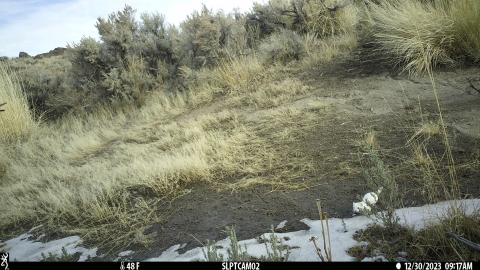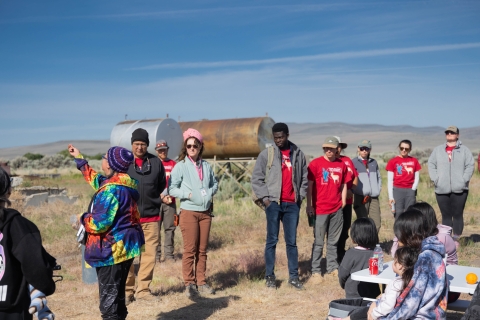The following story was written by partners at the Intermountain West Joint Venture and the full original version * is available on their Partners in Sage website.
*When you use the above link, you are leaving the USFWS website. DOI and the bureaus do not guarantee that outside websites comply with Section 508 (Accessibility Requirements) of the Rehabilitation Act. Links also do not constitute endorsement, recommendation, or favoring by the U.S. Fish and Wildlife Service.
✦ ✦ ✦
Upon cresting the south ridge of the Summit Lake Paiute Tribe’s land, the entirety of their 14,000-acre reservation is revealed with a shimmering lake at its heart. Green ribbons of riparian riparian
Definition of riparian habitat or riparian areas.
Learn more about riparian -lush creeks thread down sagebrush sagebrush
The western United States’ sagebrush country encompasses over 175 million acres of public and private lands. The sagebrush landscape provides many benefits to our rural economies and communities, and it serves as crucial habitat for a diversity of wildlife, including the iconic greater sage-grouse and over 350 other species.
Learn more about sagebrush slopes to feed the lake, which supports a genetically distinct Summit Lake strain of Lahontan cutthroat trout. Antelope, mule deer, sage grouse, jackrabbits, and short-eared owls crisscross the earth and sky. Tucked into the high desert’s folds is a smattering of springs that bubble straight out of volcanic rock and soil.
Chairwoman Randi Lone Eagle said her tribe has creation stories about how everything there came to be, how the animals were there first, and then how the people came. The Summit Lake Paiute are unique because not all of the tribal members live on their reservation full time due to its remote location and limited infrastructure. Chairwoman Lone Eagle said this also means that the land is particularly remarkable, intact, and healthy, which is why the tribe is so dedicated to conservation.
“We are preserving what's left for us,” she said. “A lot of tribal members see it as our very special place. We want to keep it the way that it is. Over time, with environmental impacts like from the wild horse and cattle, those areas are not able to go back to the way that they were if we don’t help them heal.”
Unmanaged grazing can do extensive damage to the reservation’s high-elevation arid desert habitats. Wetlands and natural springs in particular are sensitive to overgrazing and soil impactment. Despite increased collaboration with Federal agencies and local ranchers, recent round-ups, and fence repairs around the perimeter of the Reservation, the unmanaged grazing continues. Permanent stout fencing infrastructure around these spring water sources is an important long-term solution, but it’s an expensive one.
“Our ideal goal is to restore these springs to their historic or proper functioning condition,” said James Simmons, director of the tribe’s Natural Resources Department.
While visiting the springs this summer, Simmons remarked on the sounds of the bubbling water, beautiful and rare in the middle of the high desert. Soon after, a clutch of sage grouse chicks exploded from the spring’s grasses and late-blooming wildflowers.
Knowing how fragile and biologically valuable these microhabitats are, when Simmons saw the application period open for Bipartisan Infrastructure Law Bipartisan Infrastructure Law
The Bipartisan Infrastructure Law (BIL) is a once-in-a-generation investment in the nation’s infrastructure and economic competitiveness. We were directly appropriated $455 million over five years in BIL funds for programs related to the President’s America the Beautiful initiative.
Learn more about Bipartisan Infrastructure Law funding to help build the fences these springs need, he immediately started pulling together a project proposal.
Cheryl Mandich at the U.S. Fish and Wildlife Service (USFWS) was excited to receive Simmons’ project proposal and a few months later informed him that it was approved for funding. Mandich works for the USFWS Partners for Fish and Wildlife Program, which provides land managers with technical and financial resources to enact habitat conservation. With this funding and additional leverage dollars in place, contract crews were brought in to install hefty pipe rail exclosure fences around the springs and their associated meadows in 2023 and 2024. The tribe’s natural resource staff will monitor vegetation and wildlife response to the project for multiple years to ensure recovery.
Now, at the height of summer, field crews from the tribe’s natural resources department are working in every habitat type. During the day they might be monitoring the lake’s water quality; managing contractors spraying invasive plants; counting trout fry in the creeks; or swapping out memory cards from the many game cameras used to monitor projects. Daytime temperatures in July are hitting the high 90s, so things get even busier by night. Crews track sage grouse broods with telemetry, document reptiles and amphibians, and otherwise study all manner of critters that the nighttime hours reveal.
The high desert springs in particular are a hub of activity. The natural resource staff have cameras and acoustic monitoring devices placed on all of the reservation’s springs, and they started tracking wildlife presence there a few years ago. Game cameras have documented many typical sagebrush species visiting these springs. One unique visitor seen on the game cameras is an ermine.
“We didn’t even know ermine were here!” said Simmons. “We have pictures of them in their white winter coats as well as brown summer ones.”
The spring fencing project is part of Simmons and his staff’s efforts to maintain the tribe’s sovereignty in protecting the environment and natural resources of their reservation. Tribal members continue to hunt, fish, gather traditional foods and medicine, and conduct spiritual and religious practices on their reservation, as they have since time immemorial.
“My relatives, the people before me, always told us to protect our land and our waters. And I just grew up always knowing that's what we do,” said Nedra Crane, Vice Chairwoman of the Summit Lake Paiute. “I hope that they continue what myself and the people before me are doing. It's important to protect our land, natural resources, wildlife, burial sites, and ceremonies because all that will always be performed on the reservation for the tribal members.”
The Summit Lake Paiute Reservation is a treaty-designated area established in 1913, restricting nomadic people into an area that is tiny compared to the vast region of the Great Basin they once traveled following seasonal food resources. The reservation is closed to those who are not tribal members or staff, a measure that likely contributes to the tribe’s ability to protect the natural resources on their sovereign land. The public may drive through their lands en route to surrounding areas, but no visitation is allowed without permission.
“The tribe has such a powerful connection to this land and they highly value having intact ecosystems here,” Simmons said. “They say there’s comfort in knowing that even though they don’t all live there now, it’s there for them when they need it. They won’t be able to return to the same land if the natural resource systems here are destroyed.”
Mandich and Simmons are also working with the Summit Lake Paiute Tribe and the Nevada Department of Wildlife on another Bipartisan Infrastructure Law-funded project, this time to implement an aerial application of herbicide to treat cheatgrass. The project will use a contract pilot to treat cheatgrass areas across the Sheldon National Wildlife Refuge, the reservation, and Bureau of Land Management land.
“Cheatgrass is such a daunting, huge issue in Nevada. It’s demoralizing,” Mandich said. “But this funding will allow a conservation activity to be implemented on the reservation and on public lands immediately outside those boundaries. The near-permanent protection of multiple springs was already plenty to celebrate, but now these relatively small fencing projects have opened the door to landscape-scale conservation opportunities because of the tribe’s willingness to work with multiple partners.”
Simmons describes this cross-fenceline project—with federal lands being treated right next door to the reservation—as an opportunity to create an extended buffer of conserved habitat. By addressing large tracts of land, the partners can expand their conservation results.
“The reservation is small enough and the issues aren’t overwhelming enough that I hope we can actually achieve this,” Simmons said.
For Chairwoman Lone Eagle, her hope for this conservation work extends to the young people living in the Reno area as well as those tribal members that want to retire near Summit Lake.
“I hope that one day the community will be able to thrive and to actually go back to living on the reservation,” she said. “The land itself, that's our homeland. That's where a lot of our ancestors are still are. That's where we go to pray. That's where we go to be in our spiritual way, our traditional ways, and in alignment with the water, the sagebrush, and the landscape. Again, that’s why it’s important to preserve what we have."













